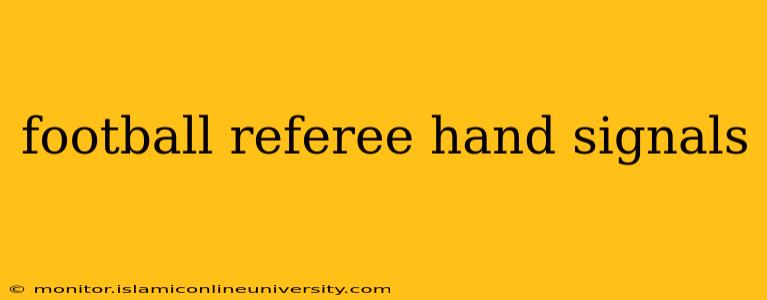Football (soccer) referees use a complex system of hand signals to communicate decisions quickly and clearly to players, coaches, and spectators. Understanding these signals is crucial for anyone who wants a deeper appreciation of the game. This guide will break down the most common hand signals, explaining their meaning and offering tips for better understanding on-field actions.
What are the basic hand signals used by football referees?
The basic hand signals are designed to be easily visible and unambiguous, even from a distance and during fast-paced game situations. They are broadly categorized into signals indicating fouls, advantages, substitutions, and time-keeping. The specific hand gestures often vary slightly depending on the referee's individual style and the specific context, but the overall meaning remains consistent.
What does the referee's hand signal for a goal mean?
A goal is signaled by the referee raising both arms straight above their head, pointing upwards. This is a clear, unmistakable signal that the ball has fully crossed the goal line between the goalposts and under the crossbar. No other signal is required; this gesture alone signifies a goal.
What does it mean when a football referee raises their arm?
Raising one arm signals different things depending on the context. A raised arm straight up and extended usually means a stoppage in play. This can occur because of a foul, an injury, or to indicate the end of a half or the full-time whistle. If the arm is angled differently or combined with other signals, the meaning may vary. For example, a raised arm with a circular motion might be used to signal a throw-in.
What is the hand signal for a free kick?
A free kick is generally signified by extending one arm straight out horizontally. The location of the free kick will be indicated by the referee's position and potentially other gestures. The specific type of free kick (direct or indirect) will usually be indicated verbally or through other supplementary signals or positioning.
What is the hand signal for a corner kick?
A corner kick is signaled by the referee pointing towards the corner flag. This is a simple and clear signal, eliminating any confusion about the location of the kick.
What does the referee do to signal offside?
The referee will raise their flag to indicate an offside offense. The raised flag signals to the linesman (assistant referee) that an offside is in progress, and the main referee will then usually make the decision to signal it. The referee will often point towards the player who was offside.
What are other common football referee hand signals?
Many other hand signals are used, including:
- Penalty kick: The referee points to the penalty spot with their arm outstretched.
- Throw-in: The referee will usually indicate the location of the throw-in and possibly use an arm motion suggestive of a throwing action.
- Indirect free kick: Often indicated in conjunction with the arm extended for a free kick but with an additional movement to show the nature of the kick. The exact motion varies between referees, but the communication is clear that it is indirect.
- Yellow card: The referee will hold up a yellow card to show a warning for misconduct.
- Red card: The referee holds up a red card to show a player must leave the field due to a serious foul or repeated misconduct.
- Substitution: The referee signals a substitution using a specific hand signal, often involving pointing to the side that a player is to exit the field.
Understanding these hand signals enhances your viewing experience and your ability to interpret the flow of the game. While subtle variations might exist, the core meanings remain consistent across professional and amateur football matches. Remember to observe the context and look for further cues to confirm the referee's indication.
